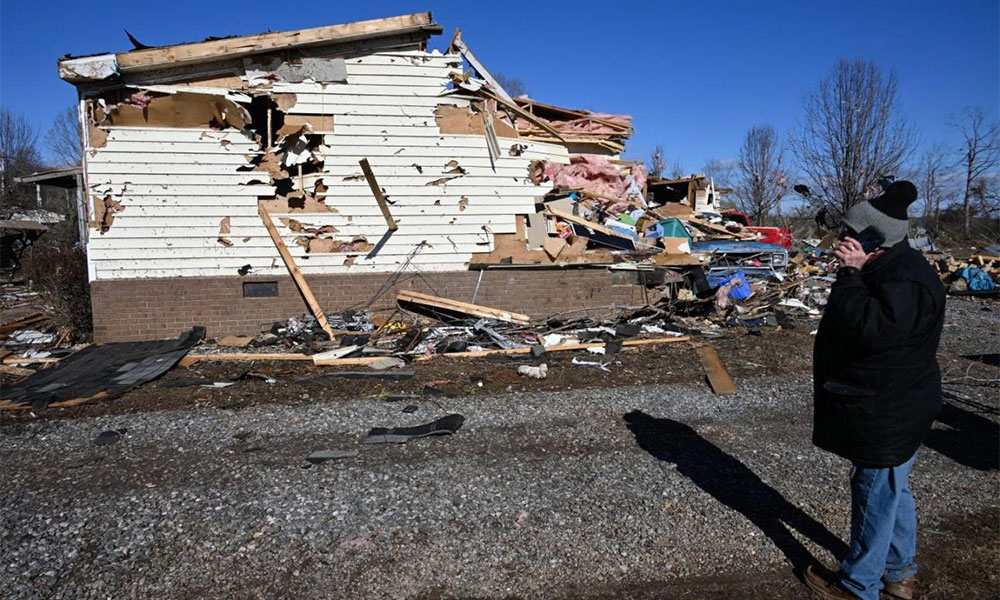
氣候風險對于房地產(chǎn)市場而言,,是一個價值22萬億美元的嚴重問題,,而且它只會變得越來越嚴重。Realtor.com最新發(fā)布的一份報告,,評估了洪水,、風災(zāi)、野火,、高溫和空氣質(zhì)量等問題,。報告稱,美國約44.8%的住宅(價值近22萬億美元)面臨“至少一種嚴重或極端氣候風險”,。經(jīng)濟學(xué)家許佳一(音譯:Jiayi Xu),、經(jīng)濟數(shù)據(jù)經(jīng)理塞布莉娜·斯培努以及首席經(jīng)濟學(xué)家丹尼爾·黑爾等報告作者認為,這代表接近22萬億美元的房屋價值,。
此外,,還有40.4%的住宅面臨嚴重或極端的高溫、風災(zāi)和空氣質(zhì)量風險,,價值高達19.7萬億美元,。許佳一在一份單獨的新聞稿中表示:“氣候風險非常嚴重。它可能影響房屋價值,、保險成本和房地產(chǎn)市場的整體穩(wěn)定性,?!?/p>
許佳一表示,在一些情況下,,“在高氣候風險和低房價地區(qū),,人們不得不忍受這些風險,以獲取更經(jīng)濟實惠的住房,?!?/p>
相對于其他氣候或環(huán)境相關(guān)風險,受到洪水和野火風險威脅的房屋比例較小,。高溫是重大風險,,全美受高溫影響的房屋比例最大,約32.5%的房屋面臨嚴重或極端高溫風險,,這些房屋價值接近13.6萬億美元,。在邁阿密,面臨“嚴重或極端風險”的住宅價值最高,,其他17個大都市區(qū)同樣面臨風險,。報告稱,這些面臨風險的地區(qū)位于佛羅里達州,、德克薩斯州,、南卡羅萊納州、路易斯安納州和弗吉尼亞州,。
此外還有風災(zāi)或颶風風險,,有18.1%的住宅受到影響,價值約7.7萬億美元,。而按照總住宅價值計算,,邁阿密依舊是風險最嚴重的地方。受高溫風險威脅的州,,除了弗吉尼亞州以外,,同樣面臨颶風風險。
雖然空氣質(zhì)量風險似乎很少被作為住宅面臨的風險進行討論,,但實際上全美有9%的住宅受到影響(價值約6.6萬億美元),。報告中寫道:“舊金山面臨嚴重或極端空氣質(zhì)量風險的住宅總價值最高,而加州和華盛頓州的四個大都市區(qū)同樣面臨嚴重或極端空氣質(zhì)量風險,?!?/p>
其次是洪水風險,有約6.6%的住宅面臨嚴重或極端洪水和洪水損失風險,。這些住宅的價值約為3.4萬億美元,,而且主要集中在邁阿密,該市是“面臨嚴重或極端洪水風險的住宅總價值最高的”城市,。但在面臨風險的房屋價值占比方面,,排在最前列的城市則是新奧爾良,。
當然還有野火風險。眾所周知,,野火是加州的一個嚴重問題,。約5.5%的住宅(價值3萬億美元)面臨嚴重或極端火災(zāi)損失風險;約39.1%的“高風險”住宅位于加州,,價值1.7萬億美元,。而受到威脅的住宅總價值最高的城市是洛杉磯,。
許表示,,先把房屋損毀和生活受影響等更嚴重、更可怕的后果放在一邊,,“問題在于你能否獲得經(jīng)濟實惠的保險,,以及保險成本會增加多少?!?/p>
《財富》雜志此前曾報道過,,沒有保險的房屋是一個嚴重問題,可能讓因為高房價和高抵押貸款利率已經(jīng)出現(xiàn)嚴重可負擔性危機的房地產(chǎn)市場進一步惡化,。去年,,極端天氣給美國造成了至少230億美元損失(有23次嚴重的氣候事件,至少造成10億美元損失),。一名CoreLogic的高管此前曾對《財富》雜志表示:“很可惜,,嚴重氣候事件可能變得更嚴重,發(fā)生頻率更高,?!奔又莺头鹆_里達州的業(yè)主已經(jīng)有切身體會。加州的業(yè)主發(fā)現(xiàn),,財產(chǎn)保險公司設(shè)定了開出保單的數(shù)量上限,,或者拒絕提供新保單;而有多家保險公司直接選擇離開佛羅里達州,。
二月,,美國通脹連續(xù)第二個月保持較高水平,沒有朝著美聯(lián)儲2%的目標進一步下降,,這間接意味著抵押貸款利率會在更長時間內(nèi)保持更高水平,。就在上周,美聯(lián)儲主席杰羅姆·鮑威爾在國會聽證會上表示,,保險成本飆升是通脹維持高水平的主要原因之一,。他說道:“過去幾年,各種保險,,包括房屋保險,、汽車保險等,,都是通貨膨脹的重要來源?!滨U威爾特別提到房地產(chǎn)市場時表示:“從長遠來看,,保險公司正在停止為一些沿海地區(qū)提供保險……這是個嚴重問題?!保ㄘ敻恢形木W(wǎng))
翻譯:劉進龍
審校:汪皓
1月,,北卡羅來納州克萊蒙特,一棟房子被強風摧毀,。
氣候風險對于房地產(chǎn)市場而言,,是一個價值22萬億美元的嚴重問題,而且它只會變得越來越嚴重,。Realtor.com最新發(fā)布的一份報告,,評估了洪水、風災(zāi),、野火,、高溫和空氣質(zhì)量等問題。報告稱,,美國約44.8%的住宅(價值近22萬億美元)面臨“至少一種嚴重或極端氣候風險”,。經(jīng)濟學(xué)家許佳一(音譯:Jiayi Xu)、經(jīng)濟數(shù)據(jù)經(jīng)理塞布莉娜·斯培努以及首席經(jīng)濟學(xué)家丹尼爾·黑爾等報告作者認為,,這代表接近22萬億美元的房屋價值,。
此外,還有40.4%的住宅面臨嚴重或極端的高溫,、風災(zāi)和空氣質(zhì)量風險,,價值高達19.7萬億美元。許佳一在一份單獨的新聞稿中表示:“氣候風險非常嚴重,。它可能影響房屋價值,、保險成本和房地產(chǎn)市場的整體穩(wěn)定性?!?/p>
許佳一表示,,在一些情況下,“在高氣候風險和低房價地區(qū),,人們不得不忍受這些風險,,以獲取更經(jīng)濟實惠的住房?!?/p>
相對于其他氣候或環(huán)境相關(guān)風險,,受到洪水和野火風險威脅的房屋比例較小。高溫是重大風險,,全美受高溫影響的房屋比例最大,,約32.5%的房屋面臨嚴重或極端高溫風險,,這些房屋價值接近13.6萬億美元。在邁阿密,,面臨“嚴重或極端風險”的住宅價值最高,,其他17個大都市區(qū)同樣面臨風險。報告稱,,這些面臨風險的地區(qū)位于佛羅里達州,、德克薩斯州、南卡羅萊納州,、路易斯安納州和弗吉尼亞州,。
此外還有風災(zāi)或颶風風險,有18.1%的住宅受到影響,,價值約7.7萬億美元,。而按照總住宅價值計算,邁阿密依舊是風險最嚴重的地方,。受高溫風險威脅的州,除了弗吉尼亞州以外,,同樣面臨颶風風險,。
雖然空氣質(zhì)量風險似乎很少被作為住宅面臨的風險進行討論,但實際上全美有9%的住宅受到影響(價值約6.6萬億美元),。報告中寫道:“舊金山面臨嚴重或極端空氣質(zhì)量風險的住宅總價值最高,,而加州和華盛頓州的四個大都市區(qū)同樣面臨嚴重或極端空氣質(zhì)量風險?!?/p>
其次是洪水風險,,有約6.6%的住宅面臨嚴重或極端洪水和洪水損失風險。這些住宅的價值約為3.4萬億美元,,而且主要集中在邁阿密,,該市是“面臨嚴重或極端洪水風險的住宅總價值最高的”城市。但在面臨風險的房屋價值占比方面,,排在最前列的城市則是新奧爾良,。
當然還有野火風險。眾所周知,,野火是加州的一個嚴重問題,。約5.5%的住宅(價值3萬億美元)面臨嚴重或極端火災(zāi)損失風險;約39.1%的“高風險”住宅位于加州,,價值1.7萬億美元,。而受到威脅的住宅總價值最高的城市是洛杉磯。
許表示,,先把房屋損毀和生活受影響等更嚴重,、更可怕的后果放在一邊,,“問題在于你能否獲得經(jīng)濟實惠的保險,以及保險成本會增加多少,?!?/p>
《財富》雜志此前曾報道過,沒有保險的房屋是一個嚴重問題,,可能讓因為高房價和高抵押貸款利率已經(jīng)出現(xiàn)嚴重可負擔性危機的房地產(chǎn)市場進一步惡化,。去年,極端天氣給美國造成了至少230億美元損失(有23次嚴重的氣候事件,,至少造成10億美元損失),。一名CoreLogic的高管此前曾對《財富》雜志表示:“很可惜,嚴重氣候事件可能變得更嚴重,,發(fā)生頻率更高,。”加州和佛羅里達州的業(yè)主已經(jīng)有切身體會,。加州的業(yè)主發(fā)現(xiàn),,財產(chǎn)保險公司設(shè)定了開出保單的數(shù)量上限,或者拒絕提供新保單,;而有多家保險公司直接選擇離開佛羅里達州,。
二月,美國通脹連續(xù)第二個月保持較高水平,,沒有朝著美聯(lián)儲2%的目標進一步下降,,這間接意味著抵押貸款利率會在更長時間內(nèi)保持更高水平。就在上周,,美聯(lián)儲主席杰羅姆·鮑威爾在國會聽證會上表示,,保險成本飆升是通脹維持高水平的主要原因之一。他說道:“過去幾年,,各種保險,,包括房屋保險、汽車保險等,,都是通貨膨脹的重要來源,。”鮑威爾特別提到房地產(chǎn)市場時表示:“從長遠來看,,保險公司正在停止為一些沿海地區(qū)提供保險……這是個嚴重問題,。”(財富中文網(wǎng))
翻譯:劉進龍
審校:汪皓
Climate risk is a $22 trillion problem for the housing market—and it’s only set to keep growing. Almost 44.8% of homes across the country, worth nearly $22 trillion, are staring down “at least one type of severe or extreme climate risk,” according to a newly released Realtor.com report which considered flood, wind, wildfire, heat, and air quality issues. That represents nearly $22 trillion of housing wealth, concluded the authors, economist Jiayi Xu, economic data manager Sabrina Speianu, and chief economist Danielle Hale.
More so, 40.4% of homes, worth $19.7 trillion, are at severe or extreme risk when it comes to heat, wind, and air quality. “Climate risk is a big deal,” Xu said in a separate release. “It can impact home values, insurance costs, and the overall stability of a housing market.”
And in some cases, “in areas with high climate risk and lower home prices, people are tolerating these risks in exchange for more affordable housing,” Xu said.
The share of homes threatened by flood and wildfire risk is smaller than any other weather or environment-related risk. Heat risk is the big one, affecting the largest percentage of homes across the country, roughly 32.5%, valued at nearly $13.6 trillion, holding a severe or extreme risk of heat exposure. Miami has the highest value of homes at “severe or extreme risk,” but 17 other metropolitan areas are also at risk. That includes areas in Florida, Texas, South Carolina, Louisiana and Virginia, according to the report.
Then there’s wind, or hurricane risk, which affects around 18.1% of homes worth almost $7.7 trillion. And yet again, Miami faces the most substantial risk, in terms of its total value of homes. The states threatened by hurricane risk are similar to those threatened by the heat, aside from Virginia.
Air quality risk, which doesn’t seem to be discussed much as a threat to homes, can actually impact 9% of homes in the nation (so almost $6.6 trillion). “San Francisco holds the highest total value of homes at severe or extreme air quality risk, whereas four metros from California and Washington are all at severe or extreme air quality risk,” the report reads.
Flood risk comes next, with about 6.6% of homes facing severe or extreme risk of flooding and flood damage. Those homes are worth almost $3.4 trillion, and they’re largely concentrated in Miami, given the city has the “highest total value of homes at severe or extreme risk of floods.” That being said, New Orleans comes up top in terms of the share of property value at risk.
And of course, there’s wildfire risk, which we all know is largely a California problem. Roughly 5.5% of homes, worth $3 trillion, are at severe or extreme risk of fire damage; almost 39.1% of “high-risk” homes are in California; those are worth $1.7 trillion. And the highest total value of homes threatened are in Los Angeles.
Putting to one side the more serious and dire consequences, such as the destruction of homes and peoples’ lives, “the issues are whether you can get access to affordable insurance and how much the costs will increase,” Xu said.
Fortune has previously reported that uninsurable properties are a serious factor further elevating an already seriously unaffordable housing market marked by high home prices and high mortgage rates. Last year, extreme weather cost the country at least $23 billion (there were 23 major weather events that caused at least $1 billion in damage). And “the severity and frequency of major weather events, unfortunately, is likely to go up,” a CoreLogic executive previously told Fortune. California and Florida homeowners have already felt the pain. The former saw property insurers cap the number of policies they write or refuse to write new policies; the latter saw multiple insurers simply flee.
February was also the second month that inflation was “sticky,” refusing to come down further to the Federal Reserve’s 2% target, which indirectly means that mortgage rates will be higher for longer. Just last week, Fed chair Jerome Powell testified to Congress that soaring insurance costs are one of the key reasons that inflation is just, well, sticking around. “Insurance of various different kinds—housing insurance, but also automobile insurance, and things like that—that’s been a significant source of inflation over the last few years,” he said. More specifically, with a focus on housing, Powell said: “In the longer term, companies are withdrawing from writing insurance in some coastal areas…It’s a significant issue.”






